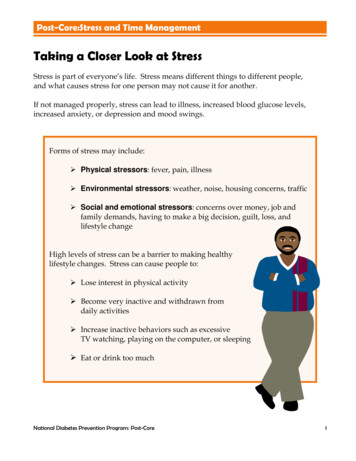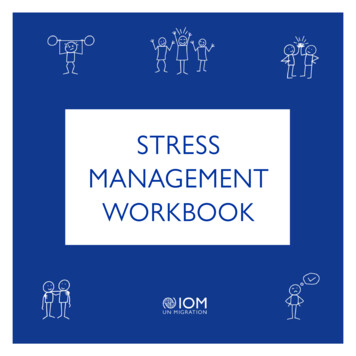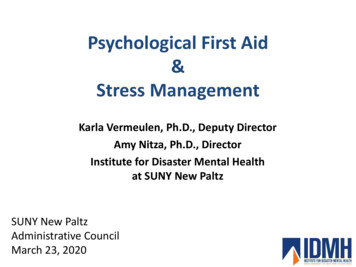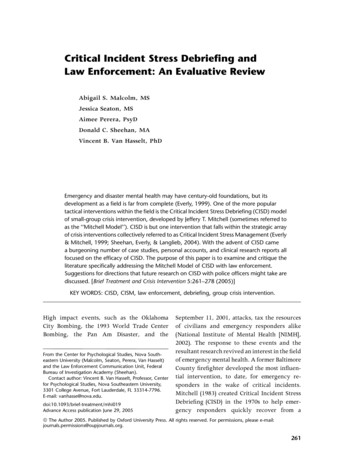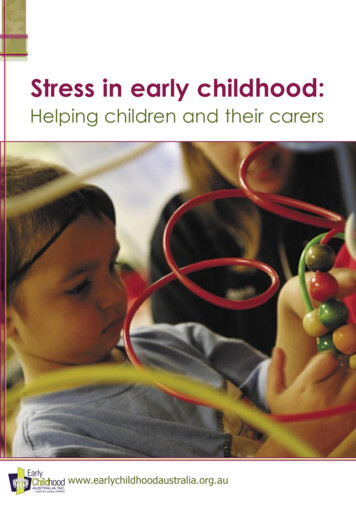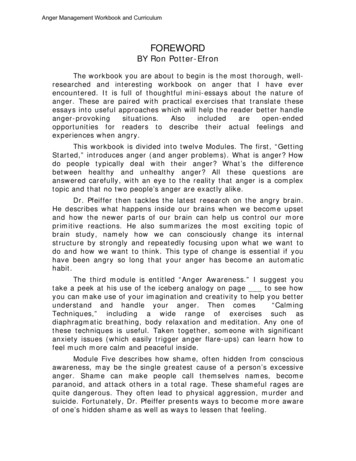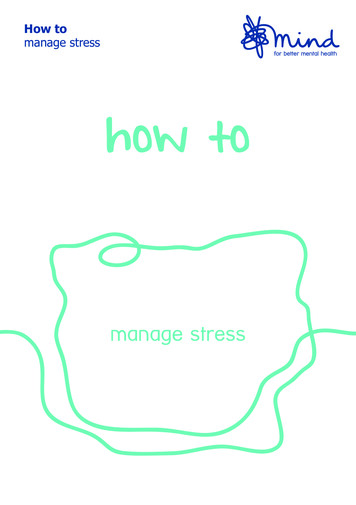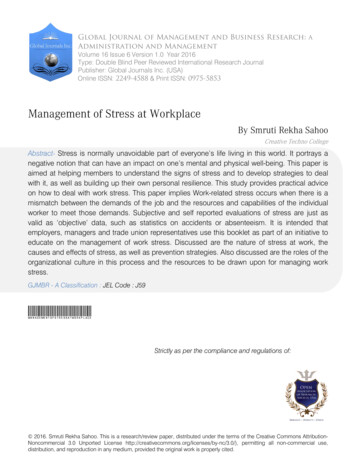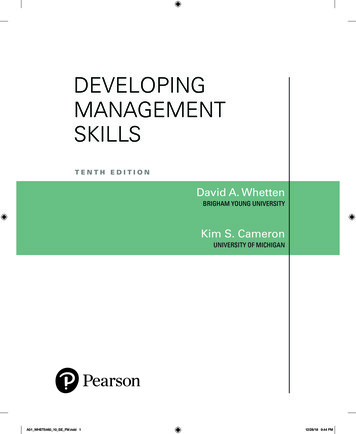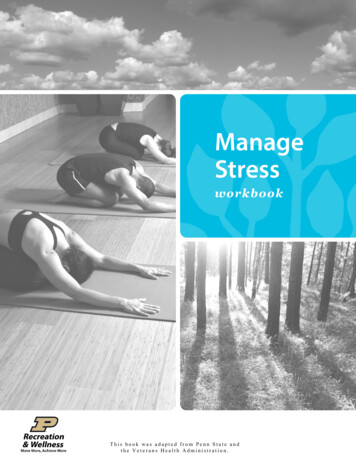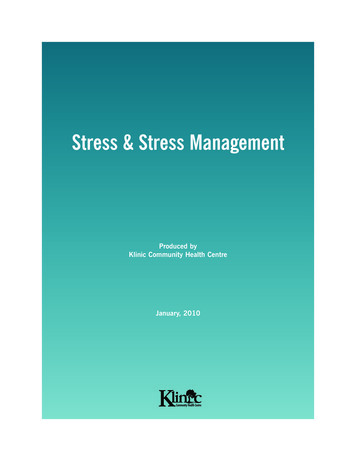
Transcription
Stress & Stress ManagementProduced byKlinic Community Health CentreJanuary, 2010
Stress & Stress ManagementProduced by Klinic Community Health Centre,January, 2010Table of ContentsIntroduction.2Stress: What is it?.3Sources of Stress .4Types of Stressors .4Internal Sources of Stress and Anxiety .6Cognitive Aspects of Stress and Anxiety .6Anxious Thoughts.8Signs and Symptoms of Stress Overload .8Effects of Stress .1050 Common Signs and Symptoms of Stress.10Diagram of the Effects of Stress on the Body .11Questions to Consider When Assessing for Stress .12The Stress Response .13The Relaxation Response .14Stress Relieving Techniques.15Mindfulness.15How to do a Mindfulness Exercise .1510 Simple Ways to Practice Mindfulness Each Day .18Relaxation in a Hurry .18Relaxing Your Body at Work .19Exercises.20Progressive Muscle Relaxation .21Deep Breathing.22Guided Imagery .23Self Massage and Self Massage Techniques .24Thought Stopping Techniques.26List of 38 Stress Busters.28References .29Stress & Stress Management1
IntroductionStress is a fact of everyday life. When people reach out forhelp, they are often dealing with circumstances, situations,and stressors in their lives that leave them feeling emotionallyand physically overwhelmed. Many people feel that they havevery little resources or skills to deal with the high levels ofstress they are experiencing.The information in this manual has been compiled to provideinformation and education about stress, the effects of stress,and the most popular stress management and relaxation techniques that are being used today. This information could behelpful for people who want to learn how to react to stress ina more constructive, proactive way. The basic premise of thismanual is that the benefits of stress reduction and relaxationtechniques can be best noticed after they have been practicedregularly over a period of time.Stress & Stress Management2
Stress: What is it?Although we all talk about stress, it often isn’t clear what stress is really about. Many people consider stress to be something that happens to them, an event such as an injury or ajob loss. Others think that stress is what happens to our body, mind, and behavior inresponse to an event (E.g. heart pounding, anxiety, or nail biting). While stress doesinvolve events and our response to then, these are not the most important factors. Ourthoughts about the situations in which we find ourselves are the critical factor.When something happens to us, we automatically evaluate the situation mentally. Wedecide if it is threatening to us, how we need to deal with the situation, and what skills wecan use. If we decide that the demands of the situation outweigh the skills we have, thenwe label the situation as “stressful” and react with the classic “stress response.” If wedecide that our coping skills outweigh the demands of the situation, then we don’t see itas “stressful.”Stress can come from any situation or thought that makes you feel frustrated, angry, oranxious. Everyone sees situations differently and has different coping skills. For this reason,no two people will respond exactly the same way to a given situation.Additionally, not all situations that are labeled “stressful” are negative. The birth of a child,being promoted at work, or moving to a new home may not be perceived as threatening.However, we may feel that situations are “stressful” because we don’t feel fully prepared todeal with them.Stress is a normal part of life. In small quantities, stress is good; it can motivate you andhelp you become more productive. However, too much stress, or a strong response tostress can be harmful. How we perceive a stress provoking event and how we react to itdetermines its impact on our health. We may be motivated and invigorated by the eventsin our lives, or we may see some as “stressful” and respond in a manner that may have anegative effect on our physical, mental, and social well-being.If we always respond in a negative way, our health and happiness may suffer. By understanding ourselves and our reaction to stress-provoking situations, we can learn to handlestress more effectively. In the most accurate meaning, stress management is not aboutlearning how to avoid or escape the pressures and turbulence of modern living; it is aboutlearning to appreciate how the body reacts to these pressures, and about learning how todevelop skills which enhance the body’s adjustment. To learn stress management is tolearn about the mind-body connection and to the degree to which we can control ourhealth in a positive sense.Stress & Stress Management3
Sources of StressWe can experience stress from four basic sources:The Environment – the environment can bombard you with intense and competingdemands to adjust. Examples of environmental stressors include weather, noise, crowding,pollution, traffic, unsafe and substandard housing, and crime.Social Stressors – we can experience multiple stressors arising from the demands of thedifferent social roles we occupy, such as parent, spouse, caregiver, and employee. Someexamples of social stressors include deadlines, financial problems, job interviews, presentations, disagreements, demands for your time and attention, loss of a loved one, divorce,and co-parenting.Physiological – Situations and circumstances affecting our body can be experienced asphysiological stressors. Examples of physiological stressors include rapid growth of adolescence, menopause, illness, aging, giving birth, accidents, lack of exercise, poor nutrition,and sleep disturbances.Thoughts – Your brain interprets and perceives situations as stressful, difficult, painful, orpleasant. Some situations in life are stress provoking, but it is our thoughts that determinewhether they are a problem for us.Types of StressorsSituations that are considered stress provoking are known as stressors. Stress is not alwaysa bad thing. Stress is simply the body’s response to changes that create taxing demands.Many professionals suggest that there is a difference between what we perceive as positivestress, and distress, which refers to negative stress. In daily life, we often use the term“stress” to describe negative situations. This leads many people to believe that all stress isbad for you, which is not true.Positive stress has the following characteristics: Motivates, focuses energy Is short-term Is perceived as within our coping abilities Feels exciting Improves performanceIn contrast, negative stress has the following characteristics: Causes anxiety or concern Can be short or long-term Is perceived as outside of our coping abilities Feels unpleasant Decreases performance Can lead to mental and physical problemsStress & Stress Management4
It is somewhat hard to categorize stressors into objective lists of those that cause positivestress and those that cause negative stress, because different people will have differentperceptions and reactions to particular situations. However, by generalizing, we can compile a list of stressors that are typically experienced as negative or positive to most people,most of the time.Examples of negative personal stressors can include: The death of a partner Filing for divorce Losing contact with loved ones The death of a family member Hospitalization (oneself or a family member) Injury or illness (oneself or a family member) Being abused or neglected Separation from a spouse or committed relationship partner Conflict in interpersonal relationships Bankruptcy/money problems Unemployment Sleep problems Children’s problems at school Legal problems Inadequate or substandard housing Excessive job demands Job insecurity Conflicts with team mates and supervisors Lack of training necessary to do a job Making presentations in front of colleagues or clients Unproductive and time-consuming meetings Commuting and travel schedulesExamples of positive personal stressors might include: Receiving a promotion at work Starting a new job Marriage or commitment ceremony Buying a home Having a child Moving Taking or planning a vacation Holiday seasons Retiring Taking educational classes or learning a new hobbyStress & Stress Management5
Internal Sources of Stress and AnxietyStressors are not always limited to situations where some external situation is creating aproblem. Internal events such as feelings, thoughts, and habitual behaviors can also causenegative stress.Common internal sources of distress include: Fears (e.g., fears of flying, heights, public speaking,chatting with strangers at a party) Repetitive thought patterns Worrying about future events (e.g., waiting for medical testresults or job restructuring) Unrealistic or perfectionist expectationsHabitual behavior patterns that can lead to stress include: Over scheduling Failing to be assertive Failing to set and maintain healthy boundaries Procrastination and/or failing to plan aheadCognitive Aspects of Stress and AnxietyAnxiety is a feeling that we commonly experience when faced with stressful life events.Anxiety can be one of the most distressing emotions that people feel. It is sometimescalled “fear or nervousness”. Common reactions to anxiety include:Physical Symptoms: Sweaty palms Muscle tension Racing heart Flushed cheeks Light headednessBehaviors: Avoiding situations where experiencing anxiety might occur Leaving situations when feelings of anxiety begins to occur Trying to do things perfectly or trying to control events to prevent dangerMoods: Nervous Irritable Anxious PanickyStress & Stress Management6
Thoughts: Overestimation of danger Underestimation of your ability to cope Underestimation of help available Worries and catastrophic thoughtsStressors can contribute to our feelings of anxiety. Examples of stressors that contribute tofeelings of anxiety might include trauma (being abused, being in an accident, war); illnessor death, things we are taught (“snakes will bite you”); things we observe (an article in thenewspaper about a plane crash); and experiences that seem too much to handle (giving aspeech, job promotion or termination, having a baby).The thoughts that accompany anxiety involve the perception that we are in danger or thatwe are threatened or vulnerable in some way. A threat of danger can be physical, mental,or social. A physical threat occurs when you believe that you will be physically hurt (e.g.,a snake bite, a heart attack, being hit). A social threat occurs when you believe you will berejected, humiliated, embarrassed, or put down. A mental threat occurs when somethingmakes you worry that you are going crazy or losing your mind.The perception of the threats varies from person to person. Some people, because of theirlife experiences, may feel threatened very easily and will often feel anxious. Other peoplemay feel a greater sense of safety or security. Certain life experiences such as growing upin a chaotic home with volatile surroundings may lead a person to conclude that the worldand other people are dangerous.The perception of danger and sense of vulnerability may have helped a person survive as achild. Being able to recognize danger and its early warning signs are critical to one’s emotional and physical survival. Some may have developed a very fine ability to spot andrespond to dangerous situations.As an adult, it may become important to evaluate whether or not its possible that one isover-responding to danger and threat. Perhaps the people in their adult life are not asthreatening as the people in their childhood. One might consider whether or not theirresources and abilities to cope as an adult open new and creative ways of responding tothreat and anxiety.Stress & Stress Management7
Anxious ThoughtsAnxious thoughts are future oriented and often predict catastrophe. Anxious thoughts oftenbegin with, “What if ” and end with a disastrous outcome. Anxious thoughts frequentlyinclude images of danger as well. For example, a man with a fear of public speaking may,before a talk, think, “What if I stumble over my words? What if I forget my notes? What ifpeople think I’m a fool and don’t know what I am talking about?” He may have an imageof himself standing frozen in front of the crowd. These thoughts are all about the futureand predict a dire outcome.Signs and Symptoms of Stress OverloadIt is important to learn how to recognize when your stress levels are “out of control” orhaving an adverse effect. The signs and symptoms of stress overload can be almost anything. Stress affects the mind, body, and behavior in many ways, and everyone experiencesstress differently.Three common ways that people respond when they are overwhelmed by stress are:1. An angry or agitated stress response. You may feel heated, keyed-up, overlyemotional, and unable to sit still.2. A withdrawn or depressed stress response. You shut down, space out, and showvery little energy or emotion.3. Both a tens and frozen stress response. You “freeze” under pressure and feel likeyou can’t do anything. You look paralyzed, but under the surface you may feelextremely agitated.The following lists some of the common warning signs and symptoms of stress. The moresigns and symptoms you notice in yourself, the closer you might be to feeling stress overload.Cognitive Symptoms: Memory problems Inability or difficulty concentrating Poor judgment Seeing only the negative Anxious, racing, or ruminating thoughts Constant worryingEmotional Symptoms: Moodiness Irritability or short-tempered Agitation, inability to relaxStress & Stress Management8
Feeling overwhelmed Sense of loneliness or isolation Depression or general unhappinessPhysical Symptoms: Aches and pains, muscle tension Diarrhea or constipation Nausea, dizziness, or butterflies in the stomach Chest pain or rapid heartbeat Loss of sex drive Frequent colds Shallow breathing and sweatingBehavioral Symptoms: Eating more or less Sleeping too much or too little Isolating yourself from others Procrastinating or neglecting responsibilities Using alcohol, cigarettes, or drugs to relax Nervous habits (nail biting, pacing)Keep in mind that the signs and symptoms of stress also can be caused by other psychological and medical problems. If you’re experiencing any of the warning signs of stress, it’simportant to see a doctor for an evaluation. Your doctor can help you determine whether ornot your symptoms are stress related.Stress & Stress Management9
Effects of StressStress is difficult for professionals to define because it is a highly subjective phenomenonthat differs for each of us. Things that are distressful for some individuals can be pleasurable for others. We also respond to stress differently. Some people blush, some eat morewhile others grow pale or eat less. There are numerous physical as well as emotionalresponses as illustrated by the following list of 50 common signs and symptoms of stress.50 Common Signs and Symptoms of Stress1. Frequent headaches, jaw clenching or pain26. Insomnia, nightmares, disturbing dreams2. Gritting, grinding teeth27. Difficulty concentrating, racing thoughts3. Stuttering or stammering28. Trouble learning new information4. Tremors, trembling of lips, hands29. Forgetfulness, disorganization, confusion5. Neck ache, back pain, muscle spasms30. Difficulty in making decisions6. Light headedness, faintness, dizziness31. Feeling overwhelmed7. Ringing in the ears32. Frequent crying spells or suicidal thoughts8. Frequent blushing, sweating33. Feelings of loneliness or worthlessness9. Dry mouth, problems swallowing34. Little interest in appearance, punctuality10. Cold or sweaty hands, feet35. Nervous habits, feet tapping, fidgeting11. Frequent colds, infections36. Increased frustration, irritability12. Rashes, itching, hives, “goose bumps”37. Overreaction to petty annoyances13. Unexplained or frequent allergy attacks38. Increased number of minor accidents14. Heartburn, stomach pain, nausea39. Obsessive/compulsive behaviors15. Excess belching, flatulence40. Reduced work productivity16. Constipation, diarrhea41. Lies or excuses to cover up poor work17. Difficulty breathing, sighing42. Rapid or mumbled speech18. Sudden attacks of panic43. Excessive defensiveness or suspiciousness19. Chest pain, palpitations44. Problems with communication20. Frequent urination45. Social withdrawal or isolation21. Low sexual drive or performance46. Constant tiredness, weakness, fatigue22. Excess anxiety, worry, guilt, nervousness47. Frequent use of over-the-counter drugs23. Increased anger, frustration, hostility48. Weight gain or loss without diet24. Depression, frequent or intense moodswings49. Increased smoking, alcohol, or drug use50. Excessive gambling or impulse buying25. Increased or decreased appetiteStress & Stress Management10
As demonstrated in the preceding list, stress can have wide ranging effects on emotion,mood, and behavior. Equally important but often less appreciated are effects on varioussystems, organs, and tissues all over the body, as illustrated in the following diagram.Physical or mental stressesmay cause physical illness aswell as mental or emotionalproblems. Here are the partsof the body affected by stress:Hair:High stress levels may causeexcessive hair loss and someforms of baldness.Muscles:Spasmodic pains in the neckand shoulders, musculoskeletal aches, lower backpain, and various minormuscular twitches and nervous tics are more noticeableunder stress.Digestive tract:Stress can cause or aggravate diseases of the digestivetract including gastritis,stomach and duodenalulcers, ulcerative colitis, andirritable colon.The Effects of StressBrain:Stress triggers mental andemotional problems such asinsomnia, headaches, personality changes, irritability,anxiety, and depression.Mouth:Mouth ulcers and excessivedryness are often symptomsof stress.Heart:Cardiovascular disease andhypertension are linked toaccumulated stress.Lungs:High levels of mental oremotional stress adverselyaffect individuals with asthmatic conditions.Reproductive organs:Stress affects the reproductive system causing menstrual disorders and recurrentvaginal infections in womenand impotence and premature ejaculation in men.Skin:Some individuals react tostress with outbreaks of skinproblems such as eczemaand psoriasis.Stress & Stress Management11
There are numerous emotional and physical disorders that have been linked to stressincluding depression, anxiety, heart attacks, stroke, hypertension, immune system disturbances that increase susceptibility to infections, a host of viral linked disorders ranging from the common cold to herpes to certain cancers, as well as autoimmune diseases like rheumatoid arthritis and multiple sclerosis.In addition, stress can have direct effects on the skin (rashes, hives, atopic dermatitis),the gastrointestinal system (GERD, peptic ulcer, irritable bowel syndrome, ulcerativecolitis) and can contribute to insomnia and degenerative neurological disorders likeParkinson’s disease. In fact, it is hard to think of any disease in which stress cannotplay an aggravating role or any part of the body that is not affected (see Effects ofStress on the Body diagram). This list will undoubtedly grow as the extensive ramifications of stress are increasingly being appreciated.Questions to Consider When Assessing for Stress: How do you know when you are stressed?Where do you feel stress in your body?What do you notice about your body, thoughts, and feelings when things are difficult?How do you behave when you are feeling stressed out?How do you react negatively or proactively to stress?How do you currently cope with stress?Do you (answer ‘O’ for often. ‘S’ for sometimes, or ‘R’ for rarely or never)regret being angry or short-tempered with others?feel like your emotions are getting the best of you?use alcohol, cigarettes, or drugs to cope with stress(prescription, counter, or street drugs)?have sleep problems (either sleep too much or not getting enough restful sleep)?feel like things are overwhelming or out of control?laugh or smile less than you used to?yell, cry, or withdraw a lot?feel sad, disappointed, or worried?eat too much or too little when you are stressed?feel that you are not in control of your life?have trouble letting go of things that are bothering you?blame yourself or think that nothing goes right?If you have answered often or sometimes to four or more of these questions, it may betime to address your stress.Stress & Stress Management12
The Stress ResponseThe groundwork for the modern meaning of “stress” was laid by Dr. Walter B. Cannon, aphysiologist at Harvard almost 100 years ago. He was the first to describe the “fight orflight response” as a series of involuntary physiological and biochemical changes that prepare you to deal with threats of danger. This response was critical to the survival of primitive humankind when requiring quick bursts of energy to fight or flee predators such as thesaber-toothed tiger.Hans Selye, the first major researcher on stress, was able to trace what happens in yourbody during the fight or flight response. He found that any problem, real or imagined,could cause the cerebral cortex (the thinking part of the brain) to send an alarm to thehypothalamus (the main switch for the stress response, located in the midbrain). Thehypothalamus then stimulates the sympathetic nervous system to make a series ofchanges in your body. Your heart rate, breathing rate, muscle tension, metabolism, andblood pressure all increase. Your hands and feet get cold as blood is directed away fromyour extremities and digestive system into the larger muscles that can help you fight orrun. You experience butterflies in your stomach. Your diaphragm locks. Your pupils dilate tosharpen your vision and your hearing becomes more acute.While all of this is going on, something else happens that can have long-term negativeeffects if left unchecked. Your adrenal glands start to secrete corticoids (adrenaline, epinephrine, and norepinephrine), which inhibit digestion, reproduction, growth, and tissuerepair and the responses of your immune and inflammatory systems. In other words, somevery important functions that keep your body healthy begin to shut down. The stressresponse is useful and can be necessary in times of emergency, but the frequent or unrelenting triggering of the stress response in our modern life without a balancing relaxationresponse can contribute to a number of illnesses and symptoms.The same mechanism that turned the stress response on can turn it off. This is called theRelaxation Response. As soon as you decide that a situation is no longer dangerous, yourbrain stops sending emergency signals to your brain stem, which in turn ceases to sendpanic messages to your nervous system. Minutes after the danger signals stop, the flight orfight response burns out. Your metabolism, heart rate, breathing rate, muscle tension, andblood pressure all return to their normal levels. Many professionals suggest that you canuse your mind to change your physiology for the better, and improve your health by usingthe natural restorative process called the Relaxation Response.Stress & Stress Management13
The Relaxation ResponseIn the late 1960’s, at Harvard Medical School, where Walter B. Cannon performed fight orflight experiments 50 years earlier, Herbert Benson, M.D. found that there was a counterbalancing mechanism to the stress response. Just as stimulating an area of the hypothalamus can cause the stress response, activating other areas of the brain results in its reduction. He defined this opposite state the “relaxation response”.The relaxation response is a physical state of deep rest that changes the physical andemotional responses to stress. When eliciting the relaxation response:Your metabolism decreasesYour heart beats slower and your muscles relaxYour breathing becomes slowerYour blood pressure decreasesYou return to a calmer state of being.If practiced regularly, it can have lasting effects.Eliciting the Relaxation ResponseElicitation of the relaxation response is actually quite easy. There are two essential steps:1. Repetition of a word, sound, phrase, prayer, or muscular activity.2. Passive disregard of everyday thoughts that inevitably come to mind and the returnto your repetition.The following is the generic technique that elicits the relaxation response: Pick a focus word, short phrase, or prayer that is firmly rooted in your belief system,such as “one,” “peace,” “The Lord is my Shepard,” “Hail Mary full of grace,” or“Shalom”. Sit quietly in a comfortable position. Close your eyes. Relax your muscles, progressing from your feet to your calves, thighs, abdomen,shoulders, head, and neck. Breathe slowly and naturally, and as you do, say your focus word, sound, phrase, orprayer silently to yourself as you exhale. Assume a passive attitude. Don’t worry about how well you’re doing. When otherthoughts come to mind, simply say to yourself, “Oh well,” and gently return to yourrepetition. Continue for ten to twenty minutes. Do not stand immediately. Continue sitting quietly for a minute or so, allowing otherthoughts to return. Then open your eyes and sit for another minute before rising. Practice the technique once or twice daily (e.g., before breakfast and after dinner).Stress & Stress Management14
Regular elicitation of the relaxation response has been scientifically proven to be an effective treatment for a wide range of stress-related disorders. In fact, to the extent that anydisease is caused or made worse by stress, the relaxation response can help. Other techniques for evoking the relaxation response are: Mindfulness MeditationProgressive Muscle RelaxationDeep BreathingImagerySelf-MassageStress Relieving TechniquesMindfulnessMeditation that cultivates mindfulness can be particularly effective at reducing stress, anxiety, depression, and other negative emotions. Mindfulness is the quality of being fullyengaged in the present moment, without over-thinking or analyzing the experience. Ratherthan worrying about the future or dwelling on the past, mindfulness meditation switchesthe focus on what is happening right now. Mindfulness meditation is not equal to zoningout. It takes effort to maintain your concentration and to bring it back to the presentmoment when your mind wanders or you start to drift off. But with regular practice, mindfulness strengthens the areas of the brain associated with joy and relaxation. Mindfulnessprovides a potentially powerful antidote to the common causes of daily stress such as timepressure, distraction, agitation, and interpersonal conflicts.How to do a Mindfulness Exercise Find a comfortable place to sit. It can be on a chair or on the floor, but do not slumpor slouch. Keep your posture straight but relaxed, making sure you are not rigid orstiff. Focus on your breathing. Concentrate your attention completely on your breathing. Become aware of the sensations inside your air passages as the air enters the nose. Just become aware of thatfeeling as your breath goes in and out. Do not attempt to influence or check yourbreathing; just let it happen naturally. Marvel at the quality and precision of internalsensations that are normally ignored. Wonder at how deeply you can sense the airinside you. Just allow yourself time to be aware of the air going in and out, nothingelse. Keep your mind on your breathing; become your breathing. When thoughts come into your mind, that’s o.k. Just examine the thoughts for whatthey are, as if they were some strange animal that wandered into your sight. Whenthese thoughts come into your mind, allow them to wander off on their own and wishthem well on their way. Do not get involved in the thought. Just notice that it is thereand return your focus to your breathing.Stress & Stress Management15
Treat each thought as a guest. When a thought or feeling arises, simply observe andacknowledge it. There is no need to interpret it or to use it. You might wonder whereit came from, what caused it to surface now, what purpose it serves. Notice it like aprecious jewel, turning it this way and that. If you feel yourself drifting away on athought then just return and refocus on your breathing. Use your breathing as theanchor for your mindfulness. Stay in the moment as long as you can. Continue to focus on your breathing. Aim toclear your mind completely for 5 minutes. With practice you will be able to extendthe time to twenty minutes or more. Notice the repeating thoughts. As you progress you will come to recognize that thesame thoughts are appearing, over and over, even in your calmest moments. Noticethem and let them pass by, returning your attention to your breath.The
negative effect on our physical, mental, and social well-being. If we always respond in a negative way, our health and happiness may suffer. By under-standing ourselves and our reaction to stress-provoking situations, we can learn to handle stress more effectively. In
